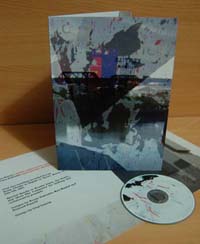I recently purchased all six of the vignettes series from Cathnor, due to a really great deal Richard was running on the Cathnor site. Cathnor has been a really great addition to the group of small labels covering this area of music, and I think a fairly distinctive taste is starting to show through, which I look forward to seeing develop more in time.
The vignettes series is currently comprised of 6 3″ CDRs, in very nice oversized packaging. Giving them the feel of some kind of audio postcard. They really (especially if you have all six) feel great to hold in your hands, and the larger format is successful in getting you to the place of absorbing the artwork as part of the experience. I’d be psyched if at the end of the series, Richard released a box for them or something, as it would seem fitting (at least to me).
Though I do have all six vignettes, I thus far have only really begun to internalize 2, due to being without a way to rip the CDs onto (or play them on) my computer.
The first is Bryan Eubanks, Ryu Hankil – 777
I have been a strong proponent of the nascent Korean improvised music scene since I first laid ears on them. There is so much experimentation going on there, and it is so well documented thanks to Balloon n Needle, the Manual, and Dotolim, that it is impossible to ignore. One of my favorite things about this scene, is the predilection towards the use of raw untreated mechanical sounds. In my mind it’s a necessary confrontation to a music which can still at times have a bit too much reverence for virtuosic technique.
One of my favorite purveyors of such sounds is Mr. Ryu Hankil. The seemingly gestureless, abstract clicks, whirs and metallic sputters of his clockworks create a world of music architecture, where micro compositions of small sounds become unique structures in a landscape. Tiny villages of sounds that one can live in for days, and still find mystery.
I was excited to hear that this outing paired Hankil and Brian Eubanks, as Eubanks back catalog bears some of my favorite releases in this area, his album “Anti-sex anti-wiretapping”, as half of GOD, is the favorite of what I’ve heard thus far.
So this was a big pairing for me, and I was really excited when my package from Richard, finally arrived. This was one of the first I listened to. The first and only piece on this disc starts out with some gentle small rattles from Hankil, and some nice textured static from Eubanks soon finds it’s way in and so the first two or so minutes of the piece are going along nicely. Hankil then switches up to a slightly different metallic texture, and Eubanks heads into a distant nineties ambient techno kind of bleeping, blooping thing. The quality of this sound is akin to something one may find on a “Techno Sound Effects of the Late Nineties” sample disc. I have to say this unfortunately sets the tone for much of the rest of the disc.
Now, I really was positive I was going to love this pairing, and I’m sure many others still will, but I have to say that Eubanks’ playing on this just does not go down well for me. If there are two things that I have no interest in hearing, one is the very transparent use of effects to create “ambience” or some sense of emotional/spiritual density, and two is thematic repetition. And Eubanks’ performance seems to be all about these things.
It’s not that he doesn’t do a good job, he does in many ways, but all I can hear are echos of Raster-Noton (and some less tasteful references) from 5-10 years ago. The question for me is, why rehash these specific sounds? Especially knowing what Eubanks is capable of. One of the things that makes the aforementioned GOD record a joy is the way in which effects are deployed in a somehow non-schlocky way, a very difficult feat seemingly pulled off with ease. But here, largely we hear what sound to these ears like the classic trappings of digital technology.
That all said, there is a lot about this record that still holds my interest. The brief moments where Eubanks eschews the ambient bloops for grainier, more tumultuous territory are really worth hearing. And Hankil, even in the midst of somewhat hostile environs, manages to pretty much play exactly what will add the right edge to stop things going into “Ambient Chillout volume 258” territory. It gives a clue as to the potential of this pairing which is imo, is just hinted at here.
It sucks to have to give this one a so-so review, as I really do want people to support Cathnor, but all in all, this one is not my cup of tea, though Hankil’s contributions I’m sure will keep me coming back, and perhaps I will at some point see through Eubanks’ playing, and find some hidden joy. If I do, I’ll be sure to report back here.
Stay tuned, I plan to review this whole series, and by far this is the one I’m most uncertain of.
Next up, Lee Patterson’s “Egg fry #2”.


